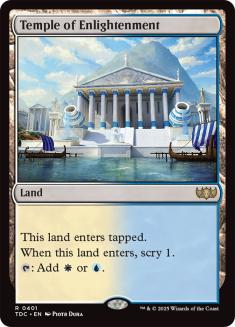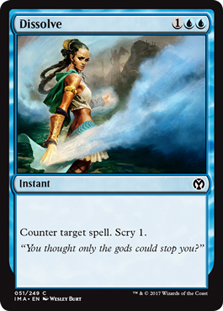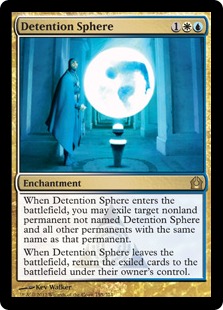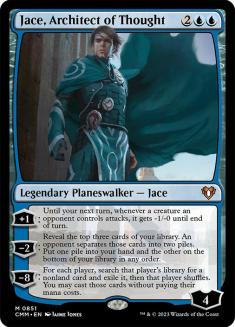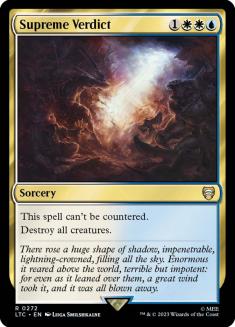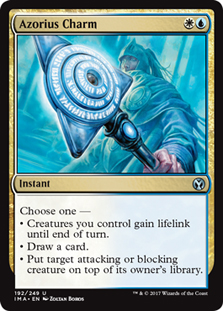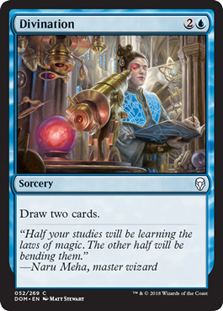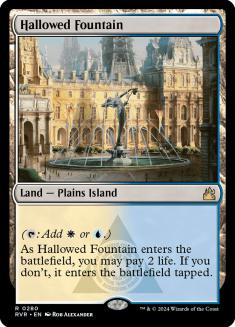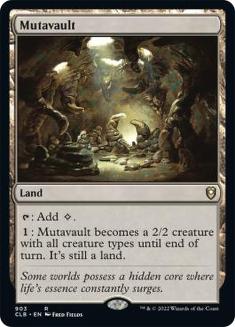"Oh my gawwd. I just totally hate Standard so much, you know? You know what I mean? Like, really. I like, totally, just, like, can’t stand it. I am so annoyed I could just, you know, just put my hands on my hips disapprovingly and swirl my gum on my finger."
"Totally. I know, right? It’s like, all I do is just discard cards to Thoughtseize and then watch my opponent discard cards to Pack Rat. I don’t even get to play Magic anymore. I just watch my opponent play. All I can do is just totally roll my eyes. It’s completely, like, just, not cool."
"Oh em gee! Exactly! We are totally like the same exact person! If we weren’t both disturbing figments of someone’s imagination that has gone grossly unchecked for many years, we would just be bestest friends!"
"Obv!"
If I’ve heard that conversation once, I’ve heard it a million times. Two valley girls just totally complaining about Standard. It’s more mainstream than the Nile.
For once, though, I’m not going to try to convince you to stop complaining about Standard. Typically, this is where I would launch into my prepared spiel about how it’s important to your growth as a Magic player to just suck it up and learn the ins and outs of the Standard format and approach it from different angles than to just throw in the towel the first time you eat a Thoughtseize into Pack Rat and get smashed by a growing horde of tokens.
"My opponent is just so lucky! I can’t believe it. He drew a Pack Rat on turn 2, and then every card the rest of the game was just another Pack Rat! What a sack!"
Instead, you can complain all you want about Standard. Have at it. I’m just going to sit in my little corner and throw out some helpful tips periodically. I’m going to be like that random guy you don’t know who walks up and interrupts your bad beat story by mentioning how you could have improved your chance of winning by making a marginally different play.
"Then her next draw was the fourth and final copy of Pack Rat. I can’t believe how unlu—"
"Well, actually your line of play on turn 4 was slightly suboptimal, and by my calculations you gave up 3.7 percentage points toward winning that game."
"Excuse me? I was the one who was irrationally complaining about a story I’m embellishing to make it seem far worse than it actually is. Could you kindly mind your own business? This is my bad beat, and you’re ruining it!"
Bad beat? More like a slightly unfortunate to get beat story.
"It looks like you suffered some bad beats by Dre that match."
"Yeah, my opponent had his single copy all three games. I forgot that card was even in Standard. That’s the last time I forget about Dre, that’s for sure."
Right. So about those Standard tips . . .
Every Standard format I notice a number of things that players instinctively do that aren’t necessarily correct. For one reason or another, these are lines of play that get ingrained into the general mindset of how to play Standard. Just because everyone does it doesn’t necessarily mean it’s the right thing to do, and I’m hoping to help correct some of those common pitfalls.
Learning these tips might not radically alter the way you play Standard, but it could definitely improve your chances of winning by that crucial 3.7 percentage points. Sometimes that’s all you need to go from the one complaining about bad beats to the one your opponent is complaining about. That’s the dream.
Last year I wrote a similar piece modeled after the hit syndicated television show 1,000 Ways To Die. I liked the idea so much that I decided I was just going to be completely and utterly unoriginal and do the same exact thing again.
"Hit me with that knowledge, baby, one more time!" -Britney Spears in a library
Without further ado, I present 1000 Ways To Scry.
#422: Blow To The Temple
One of the most common mistakes I see people make is to blow their scry effects too early in the game. J.D. Salinger allegedly once wrote a book about this very phenomenon called Catcher in the Scry. It went unpublished. Legacy players have it ingrained in their mind to save Brainstorm to use as late as possible because the longer you wait, the more information you have about what cards you want to keep and what cards you want to put back on top of your deck and hopefully shuffle away. As a game progresses, you get an increasingly clearer idea of what cards matter and what cards no longer matter.
The Temples actually aren’t any different. Sure, sometimes you have to play a Temple early because you plan to cast a spell every turn and need to have the rest of your lands come into play untapped. However, frequently players will lead with a Temple on turn 1 when they don’t actually need to, and as a result they will waste an opportunity to sculpt a better hand.
Take this hand for example:
We won the die roll and have elected to play. I feel like most players in this position just instinctively lead with the Temple of Enlightenment. I think that is a mistake. We don’t actually have any clue what kind of card we want to draw. Do we want another land? Yes, but what if we are just doing to draw that land on our next turn anyway? What if the top card is another Dissolve? Do we want that? Maybe?
The issue with scrying on turn 1 here is that there aren’t any cards that should automatically go on the top or on the bottom of our deck. It would definitely be greedy to not keep a land on top, but if that’s the case, then we aren’t getting any value out of our scry land. The rest of the cards in our deck are either good or bad depending purely on context.
By waiting a turn, we get a much better feel for what to keep. Let’s say we lead with Island. Our opponent plays a turn 1 Thoughtseize and takes our Dissolve. Mono-Black Devotion. On our turn we draw a Mutavault. Now we can play the Temple of Enlightenment and have a much better idea of what cards to leave on the top and what ones put on the bottom.
By drawing the fourth land, every spell in our hand can be cast. That provides immense information for the purposes of scrying since we now no longer need another land. I would scry any land that isn’t another Temple to the bottom. I would also scry away anything that isn’t particularly effective against Mono-Black Devotion, such as a second Supreme Verdict.
Let’s say we scry and see a Dissolve. I would leave it on top so I can counter something like an Underworld Connections. However, if instead of Swamp, Thoughtseize the opponent had led with Plains, Boros Elite, I would scry the Dissolve to the bottom. We already have a Dissolve in hand and want to instead draw more proactive cards against an aggressive deck.
Cards have context. While Dissolve might be a great card in one matchup, it’s a miserable draw in another. By waiting a turn to scry, we’ve given ourselves an opportunity to learn a lot of information that will help immensely with scry decisions. That information could easily be the difference between drawing a dead card and drawing an important card, and that can make an enormous difference in terms of who wins or loses the game.
An easy rule of thumb to follow is that if you know what you’re hoping to draw then you should scry and if you don’t know exactly what you’re looking for then you should wait to scry until you have more information unless you desperately need to play the Temple that turn to curve out properly.
For example, with a hand like this:
I would scry on turn 1 because against every single deck in the format I want to draw a land. I will put any land on top of my deck and any nonland on the bottom. I also have a turn 2 play, so I hurt myself by waiting.
Similarly, let’s say your hand is:
Let’s further say that you know your opponent is playing Mono-Black Devotion. I would scry on turn 1 here because I already know that I want to put any land on the bottom regardless of what it is and have a fairly good idea of the kind of cards I want to draw since I know what my opponent is playing.
Save your scry lands. It would really be a shame to find yourself on the bottom of six feet of standings.
#721: Landslide
One common mistake I see a lot of players make is the old classic "keep a land in hand to bluff" ploy. The idea is that you keep any extra lands in your hand so that you can bluff having actual spells in hopes of making your opponent play around your cards and make the wrong play. The biggest issue with this kind of thinking is that "extra" isn’t always accurate when it comes to lands. Sometimes those lands aren’t extra lands; they are actually lands that would benefit you in play.
While there are certainly circumstances where it’s worth keeping excess lands back to run these bluffs, the majority of the time it’s simply wrong to do this. If there are any cards you could possibly draw in your deck that would make it so you want to play the land, then you should definitely do so. Also, if there are any cards your opponent can have, like Stormbreath Dragon or Toil // Trouble, then you should also play them out.
Most of the time if you always keep one card in hand and never play it, your opponent is smart enough to connect the dots and figure out that you’re probably just sandbagging a land anyway.
For example, you’re playing U/W Control and have seven lands in play and no cards in hand. You untap and draw your eighth land. You decide to bluff a counterspell and keep it in your hand.
The next turn you draw Divination. You cast Divination and draw Island and Elspeth, Sun’s Champion. At this point you have four untapped lands in play, two lands in hand, and Elspeth. If you had played the land the prior turn, you could play the Elspeth this turn, but since you didn’t, you have to wait until next turn. It’s easy to see how this could cost you the game.
Let’s say in the same scenario you draw a Sphinx’s Revelation instead of a Divination. You play your land and cast a Revelation for five. The next turn you can play a land and cast a Revelation for six. However, if you had played the land the prior turn instead of keeping it in hand to try to bluff, then you could have instead draw the Revelation, cast it for five, and afterward played a land that you drew from the Revelation. That way if you have one more land, you can cast a Revelation for seven instead of six the following turn. Sometimes that extra card or extra life is actually immensely impactful in winning the game.
A solid rule of thumb is that if you have cards that can draw you extra cards, such as Jace or Sphinx’s Revelation, you should just always play your lands. Even if it’s your fifteenth land. You might draw a Jace, -2 into a Divination, and then draw a Sphinx’s Revelation from that. There’s no reason to pointlessly hold a land back and end up being one mana short even if it’s unlikely that it ultimately matters.
It could be the difference between a win and landing in the loser’s bracket.
#11: Rat Poison
Pack Rat is one of the hardest cards to play with in Standard. There, I said it. Someone had to.
That may seem a bit extreme. Perhaps I haven’t had the pleasure of playing a game where Pack Rat just ran roughshod over me and I couldn’t do anything about it? No, no, I certainly have played with and against Pack Rat plenty of times. I know a thing or two about eating rat. It’s a delicacy in certain parts of the world (that part of the world is whatever convention center is currently hosting a SCG Open Series). Pack Rat has certainly gone the distance against me many times. Those are speedy games. I’m usually all alone afterward in a time of need. Racing, pacing, plotting my course back home. Driving, striving, riding on my Akroan Horse.
However, games aren’t always as easy as Thoughtseize into Pack Rat. If that were the case, the finals of every Standard Open would be a Mono-Black Devotion mirror, and we both know that’s a completely laughable concept. I can’t think of a single time where that has been the case. In fact, if you can show me a single Standard Open where the finals was a Mono-Black Devotion mirror, I will jump into a vat of hot sauce and then dance in the middle of a busy intersection while . . .
Excuse me for a second—the guy on the other side of the teleprompter is making scissor motions. I think he’s trying to tell me to cut something. Let me figure out what his problem is and then we can get back to this hot sauce thing . . .
Alright, so, I’m back, and uh, apparently the finals of the last Open was actually a Mono-Black Devotion mirror. Well, folks, I guess it actually is just as easy as Thoughtseize into Pack Rat. All bets are off.
In all seriousness, though, Pack Rat can actually be a skill-intensive card. It can grant free wins, but there are also a number of situations where it takes some deft maneuvering to successfully wreck your opponent with the rat pack. There are a number of common scenarios where I see people play Pack Rat incorrectly, and I want to examine those further.
This is now the part of the article where I tell you to do the exact opposite thing I just spent a section telling you to do.
When playing Pack Rat in your deck, you actually want to hold on to extra lands. This isn’t done so that you can bluff having Hero’s Downfall. It’s done so that if you do draw a Pack Rat you immediately have fodder to pitch to it.
However, with that being said, there is also merit to playing extra lands for the reasons I elaborated on in the previous section. Let’s say you draw an Underworld Connections and activate it, drawing a Gray Merchant of Asphodel. If you don’t have enough lands in play, you can’t play both on the same turn.
Therefore, there is a definite balancing act when playing Mono-Black Devotion. You want to have enough lands in play to allow you to properly cast your spells when you draw them, but you also want to have enough excess cards in hand to fuel the Pack Rat army should one rear its very ugly head off the top of your library.
One easy rule of thumb I like to use is the "what if I draw Pack Rat this turn" metric. You can also use the "what if I draw Underworld Connections into X" metric, although it is typically more likely to draw a Pack Rat than it is to draw an Underworld Connections and then draw a specific card from the Connections.
The way this works is every time you are going to play an extra land consider whether or not you want that land in play or in your hand if you happen to draw a Pack Rat the subsequent turn. Let’s say you have four lands in hand and six in play. I would actually want to play a land that turn because that way if I do draw Pack Rat I can play an eighth land the following turn and still have two cards to discard to make two immediate Rats.
However, if I just have two lands in hand, I’m going to hold on to them. That way I can play a Pack Rat and make a Rat, and the following turn I can make two Rats since I have enough fodder to discard.
Another common mistake people make with Pack Rat is incorrectly assessing its role in the matchup. In a lot of matchups, you simply just want to go all in on Pack Rat as often as you can.
That isn’t true against decks like U/W Control. It’s extremely risky to do something like play Pack Rat on turn 2 and then immediately start making Rats. They have both Detention Sphere and Supreme Verdict to punish that kind of play. That isn’t to say that Pack Rat is bad against U/W though. I actually think Pack Rat is a fine threat against that deck.
The key is that instead of just blindly making Rats to push through more damage you want to make your Rats on the end of their turn. Play a Pack Rat on turn 2 and attack for one the following turn. If they don’t kill it, then you can make a Rat by discarding a dead removal spell on their end step and attack for four damage the next turn. If they again don’t kill your Rats, then you can just discard a card again at the end of their turn and attack for even more the next turn.
What does this accomplish? For one, it forces them to answer your Pack Rats or risk dying to them, and it does so with the least amount of investment. It may seem like you’re just getting a freeroll when you discard some dead card like Devour Flesh to a Pack Rat so it doesn’t matter if they then two-for-one you with a Detention Sphere the following turn. In reality, though, every card in hand holds value when you play a card like Pack Rat in your deck. While it may not seem like a big deal that they got all your Pack Rats and you only discarded two Devour Fleshes to fuel them, those missing Devour Fleshes from your hand are actually relevant if you later draw another copy Pack Rat and don’t have enough fuel for it at that point in the game.
Another mistake that I see made a lot is people will activate a Mutavault to push in another point or two of damage with attacking Pack Rats but leave themselves vulnerable on the swing back since they no longer can activate Mutavault to pump the Rats they have on defense. Even worse, sometimes using Mutavault to pump attacking Rats can leave the player defenseless to something like an overloaded Mizzium Mortars or a Lightning Strike to knock out a Rat. It’s not always a race with Pack Rat. Frequently, it’s correct to do a few points less damage in order to keep your Rats better protected.
It’s important to properly play this card. I would hate to see to see you have to pack it in early.
#887: Drawn & Quartered
One common mistake I often see is people using Underworld Connections and Jace, Architect of Thought to draw cards at the wrong time. That’s not to say that they shouldn’t use those cards to draw more cards, but rather that they aren’t sequencing the abilities properly with the rest of their turn.
For example, let’s say you draw a Supreme Verdict and your opponent has something like three Nightveil Specters, a Master of Waves, and 33.33 repeating Elementals in play. You’re going to cast that Supreme Verdict that turn regardless. You have a Jace on three counters that you plan on using the -2 ability on this turn. It’s actually very important to properly sequence your plays. You pretty much always want to use Jace before you do anything else. Your opponent doesn’t know that you have a Supreme Verdict, but you do. That might cause them to split the piles incorrectly.
For example, let’s say you flip over a Supreme Verdict and two Sphinx’s Revelations. They may split the piles such that both Revelations are in one pile against the Supreme Verdict. You can take both Revelations and then just cast the Supreme Verdict from your hand. Likewise, you might flip over something like Last Breath, Sphinx’s Revelation, and a land. Your opponent might offer you Sphinx’s Revelation and the land because they fear the Last Breath on their Master of Waves.
If you cast the Supreme Verdict first, then your opponent knows that they can’t rely on just the creatures they previously had in play to win the game, so they are going to split your piles differently as a result. There’s no reason to provide them with that kind of free information.
Similarly, don’t play a land before using Jace or Underworld Connections. What if you draw a Temple or a Mutavault or another land that would be better than the land you were planning on playing instead? Draw your cards before you make your decisions.
Lastly, when playing Underworld Connections, there are scenarios where you already know exactly what you are going to do for the turn regardless of what you draw. In those cases, it’s actually correct to hold off on drawing a card until the end of your opponent’s turn.
For example, let’s say you play your sixth land and cast Gray Merchant of Asphodel, leaving open the Swamp with Underworld Connections on it. There’s no real reason to use the Connections that turn since you can’t possibly cast anything you draw from it. There’s a real downside though in that your opponent could Thoughtseize you and strip the card you just drew from it. If you wait until their end step, you play around their ability to attack your hand.
If your goal is to intentionally draw into Top 8, then it’s important to intentionally draw your cards before playing your spells.
#991: Phased Out
Another common mistake I see made is in regard to removal spells. We have all been trained to save instant speed removal spells for the last possible moment to cast them. That’s not always best. There are a number of cards in Standard right now to punish that kind of play.
Personally, I’m all about timing things a bit differently. Call me old fashioned, but back in my day we used to use this little thing I like to call the main phase. You’ve probably never heard of it. It’s important to keep in mind the kind of situations where you actually just want to jam that main phase Doom Blade and send your opponent’s big fatty spiraling down the drain.
The easiest example is with Devour Flesh. It’s usually right to just cast a Devour Flesh on your turn to kill an opponent’s creature. By waiting, you open yourself up to lose to Mutavault. An easy example of this is with Nightveil Specter in the Mono-Black Devotion mirror. If your opponent goes Swamp, Swamp, Swamp, Nightveil Specter, you should definitely kill it with Devour Flesh before they can untap. Just because they’ve only played Swamps doesn’t mean they don’t have a Mutavault, and if they do have one, then you are now in serious trouble of just losing to their Specter.
Another example applies to monstrosity creatures. If you have a Doom Blade and your opponent has a Stormbreath Dragon and access to seven mana the next turn, you should probably just kill it immediately. By waiting, you offer them the chance of activating monstrosity in response to your Doom Blade and getting a few free points of damage in assuming you have other cards in hand.
Playing removal spells early can also be useful for playing around counterspells. For example, if you think Mono-Blue Devotion has brought in Negates to fight your Doom Blades, then you should aim to cast them while they’re tapped out or if not cast them in their upkeep to force them to spend mana on their turn.
A final example applies to a card like Nykthos, Shrine to Nyx. Let’s say your opponent has two Ash Zealots and you are planning on getting one with Last Breath. If you wait until their turn, then they can play and activate Nykthos before you can respond to it and generate an extra mana for their turn. If you simply remove one on your turn with the Last Breath, then they cannot generate enough devotion on their turn to get use out of Nykthos properly.
There are even more scenarios where you can get punished pretty hard for waiting too long to cast a removal spell. Generally speaking, it’s just a safe bet to fire one off as soon as you can and not give your opponent a chance to draw some sort of a card that can punish you. It goes against conventional wisdom, but overall it is just a safer way to play.
It’s important to time your spells properly. Don’t let your opponent set your phaser to stunned.
Hopefully these tips will help you hit a homerun in your next Magic tournament. Keep in mind though that there is no scrying in baseball.
Magic however is a different animal entirely. Some people like white or wheat bread. Personally, I’ve always preferred my rat sandwich on a nice thick piece of scrye. I’ll keep it on top.



